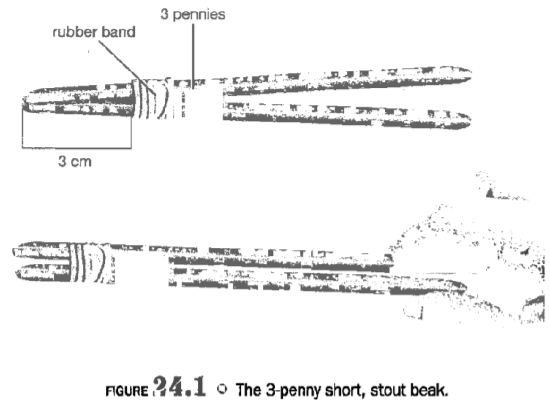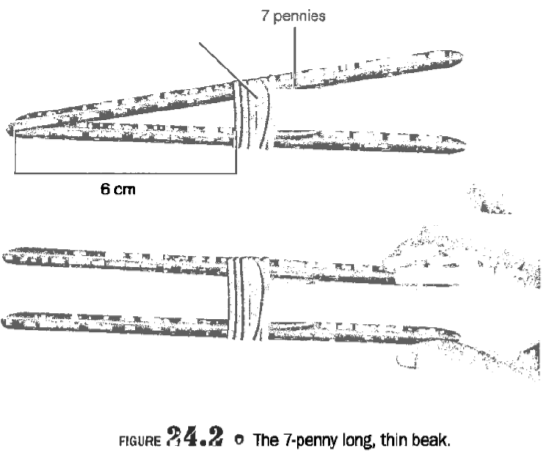1.13: Evolution
- Page ID
- 24260
Natural Selection on Bird Beak Length
While in the Galapagos Islands, Darwin noticed that the beaks of various finches were different lengths, shapes, and sizes. The differences he observed led him to several of his most important ideas about the mechanisms and processes that are responsible for descent with modification, including natural selection.
Materials Required:
- 4 wooden craft sticks
- 2 rubber bands
- 10 pennies
- Timer
- 25 large grapes
- 25 small raisins
- 1 plate
- 2 cereal bowl
Sialia mexicana (the Western bluebird) is a small passerine bird in the family Turdidae. It has a thin, straight beak and feeds primarily on worms, berries, and insects. However, it is also known to be a voracious consumer of grapes and raisins. In this exercise, you will simulate the functional consequences of variation in beak shape (short, stout beaks to long, thin beaks) of the Western Bluebird and how these might be reflected in subsequent generations. For the purposes of this activity, let's assume:
- There is a variation in beak length among individuals in a population.

- Variation in beak length is heritable.
- Individuals with one type of beak length survive or reproduce better than others.
Procedure:
- Make sure your short, stout beak (Fig. 24.1) by placing 3 pennies between two of the wooden craft sticks about 1 inch (2.54 cm.) from one end.
- Secure the wooden craft sticks together with one of the rubber bands
- Now, make your long, thin beak (Fig. 24.2) by placing 7 pennies between the remaining two wooden craft sticks (this time, approximately 2.5 inches (6.35 cm.) from one end) and secure with the final rubber band.
- Spread the raisins evenly over the surface of the plate and set your timer for 30 seconds.
- For 30 seconds, attempt to pick up as many raisins as possible with your small beak and place them in the cereal bowl.
- Record the number of raisins picked up with the small beak:______________________________________________
- Return the raisins to the plate.

- Now, attempt to pick up as many raisins as possible with the large beak and place them in the cereal bowl in the same amount of time.
- Record the number of raisins picked up with the large beak:______________________________________________
- Clear the plate.
- Spread the grapes out evenly on the plate and, again, set your timer for 30 seconds.
- Using your small beak, attempt to pick up as many of the grapes as possible in 30 seconds and place them in the bowl.
- Record the number of grapes picked up with the small beak:______________________________________________
- Now, using the large beak, attempt to place as many of the grapes as possible in the bowl in the same amount of time.
- Record the number of grapes picked up with the large beak:______________________________________________
- Return the grapes to the plate.
- In the space provided, generate a graph of your data that allows for a comparison of the efficiency of the tow beak types as collecting grapes and raisins.

- Assuming that the grapes represent the most common food source available to the Western Bluebird to be eaten in a normal year, which beak is better suited for eating/retrieving the grapes?____________________________________________________________________________________________________________
- Now, imagine that a severe drought results in there being numerous raisins available, but very few grapes. Which beak is better suited for eating/retrieving raisins? ____________________________________________________________________________________________________________________________________
- Following a drought year, how would you predict the frequency/abundance of long-beaked Western Bluebirds to change? ____________________________________________________________________________________________________________________________________ ____________________________________________________________________________________________________________________________________ ____________________________________________________________________________________________________________________________________
- Does the predicted change in abundance of birds with short, stout beaks reflecting stabilizing, disruptive, or directional selection? (Hint: Think about modes of selection.) ___________________________________________________________________________________________________________________________________
- If grapes are the most common food source for most of the years and drought occurs infrequently, how could there be variation in beak length? ____________________________________________________________________________________________________________________________________ ____________________________________________________________________________________________________________________________________ ____________________________________________________________________________________________________________________________________
Now, let's tie in all together.
- Does selection act on individuals or populations? Do individuals evolve, or do populations? Explain your answers using the Western Bluebird beak length selection activity above as an example. _____________________________________________________________________________________________________________________________________ _____________________________________________________________________________________________________________________________________ _____________________________________________________________________________________________________________________________________ _____________________________________________________________________________________________________________________________________ _____________________________________________________________________________________________________________________________________
- Describe a situation in which migration and natural selection could work in opposition to each other. Think about how the net change in allele frequencies is zero. _____________________________________________________________________________________________________________________________________ _____________________________________________________________________________________________________________________________________ _____________________________________________________________________________________________________________________________________
- Consider the 4 postulates of natural selection. How have humans manipulated each of these postulates (in natural or artificial systems)? _____________________________________________________________________________________________________________________________________ _____________________________________________________________________________________________________________________________________ _____________________________________________________________________________________________________________________________________
- Make a list of human traits that are NOT adaptive (not under selection). _____________________________________________________________________________________________________________________________________ _____________________________________________________________________________________________________________________________________ _____________________________________________________________________________________________________________________________________
- What is wrong with the statement "weak elks give themselves up to wolves for the good of the species"? (Hint: Is natural selection teleological?) _____________________________________________________________________________________________________________________________________ _____________________________________________________________________________________________________________________________________ _____________________________________________________________________________________________________________________________________
- Most mutations (source of new alleles) are random events. Why is it incorrect to say that natural selection, or adaptation, is random? _____________________________________________________________________________________________________________________________________ _____________________________________________________________________________________________________________________________________ _____________________________________________________________________________________________________________________________________


